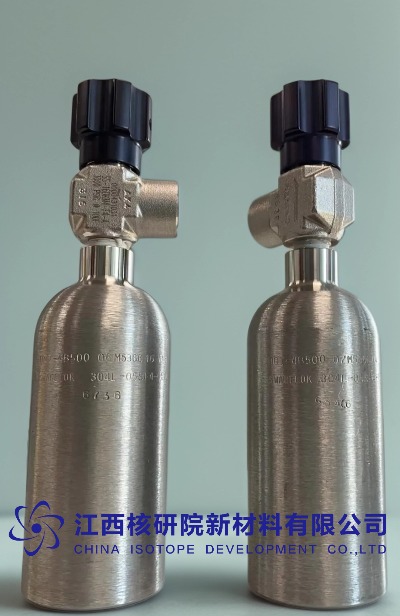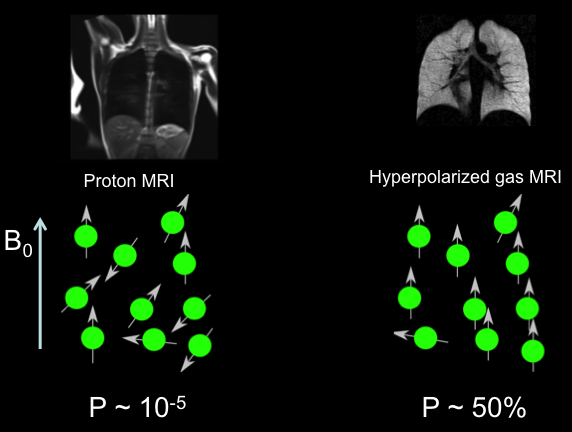Next-Gen Polarizers: Optimizing Rb/Xe-129 Spin Exchange Efficiency Beyond 75%
BY Tao, Published Aug.15, 2025
The transformative potential of hyperpolarized Xe-129 gas in medical imaging and quantum sensing hinges on achieving high nuclear spin polarization, which amplifies MRI signals by up to 100,000 times. Spin-exchange optical pumping (SEOP) with rubidium (Rb) vapor remains the cornerstone for polarizing Xe-129, yet traditional systems rarely exceed 50% polarization efficiency due to limitations in laser power, gas dynamics, and spin transfer mechanisms. As a nuclear research expert with over three decades studying rare gases and isotopes, I’ve tracked advancements in next-generation polarizers that push Rb/Xe-129 spin exchange efficiency beyond 75%, unlocking unprecedented signal quality for applications like pulmonary MRI and magnetometry. This article explores the science, innovations, and practical considerations behind these polarizers, providing a roadmap for optimizing Xe-129 polarization to meet clinical and research demands.
The Fundamentals of Rb/Xe-129 Spin-Exchange Optical Pumping
Spin-exchange optical pumping involves using circularly polarized laser light to align the electron spins of rubidium atoms, which then transfer this polarization to Xe-129 nuclei through collisions. The process occurs in a sealed cell containing Xe-129, Rb vapor, and buffer gases like helium or nitrogen, heated to 100-150°C to vaporize Rb. A laser tuned to the Rb D1 line (795 nm) excites the alkali metal, creating a highly polarized electron spin state. During Xe-129-Rb collisions, hyperfine interactions transfer this polarization to the xenon nuclei, achieving polarization levels far exceeding thermal equilibrium (0.0001% at 3T).
The efficiency of this process depends on several factors:
-
Laser Power and Linewidth: High-power, narrow-linewidth lasers maximize Rb polarization.
-
Gas Mixture Composition: Optimal Xe-129 and buffer gas ratios minimize spin relaxation.
-
Cell Design: Low-relaxation surfaces and uniform magnetic fields enhance spin transfer.
-
Temperature Control: Precise heating balances Rb vapor density with depolarization risks.
Traditional SEOP systems achieve 30-50% polarization for 100-500 mL of Xe-129, sufficient for clinical MRI but suboptimal for quantum sensing or high-throughput diagnostics. Next-generation polarizers target >75% efficiency, driven by innovations in laser technology, cell coatings, and gas dynamics, enabling stronger signals and broader applications.
Limitations of Conventional Polarizers
Conventional Rb/Xe-129 polarizers face several bottlenecks that cap efficiency at around 50%. Broad-linewidth lasers (e.g., 0.5 nm) cause incomplete Rb polarization due to off-resonance absorption, reducing spin transfer rates. High Xe-129 partial pressures increase spin-destruction collisions, lowering T1 relaxation times to 20-30 minutes. Uncoated or poorly coated cell walls induce wall relaxation, further depleting polarization. Additionally, non-uniform magnetic fields (gradients >1 mT/cm) disrupt spin coherence, while overheating Rb vapor leads to depolarization via spin-exchange collisions with unpolarized Rb atoms.
These limitations result in suboptimal signal-to-noise ratios (SNRs) in MRI (typically 100-200 at 3T) and reduced sensitivity in quantum magnetometers (100-500 fT/√Hz). Achieving >75% polarization requires addressing these challenges through advanced engineering and material science, as seen in next-gen polarizer designs.
Innovations in Next-Generation Polarizers
Recent advancements in SEOP technology are pushing Rb/Xe-129 spin exchange efficiency beyond 75%, driven by innovations across multiple domains. These breakthroughs enhance polarization yield, scalability, and operational reliability, making hyperpolarized Xe-129 more accessible for clinical and research settings.
High-Power, Narrow-Linewidth Lasers
Modern polarizers employ diode-pumped solid-state lasers or fiber-amplified systems with linewidths below 0.1 nm, ensuring near-complete Rb polarization. Power outputs of 100-200 W, compared to 20-50 W in older systems, increase photon flux, boosting spin transfer rates by 30-40%. Frequency-locked lasers maintain precise alignment with the Rb D1 line, minimizing off-resonance losses. Recent designs integrate multi-stage amplification, achieving stable outputs with <0.01 nm drift, critical for continuous-flow polarizers.
Optimized Gas Mixtures
Next-gen systems use lean Xe-129 mixtures (5-10% Xe-129, 80-90% He, 5-10% N2) to reduce spin-destruction collisions, extending T1 to 60-100 minutes. Helium minimizes Xe-Xe interactions, while nitrogen quenches Rb fluorescence, preserving electron spin polarization. Dynamic pressure control, adjusting from 1-5 bar, optimizes gas density for maximum spin transfer without compromising safety for inhalation.
Advanced Cell Coatings
Wall relaxation is mitigated with deuterated silane or polymer coatings, reducing spin flips by 50% compared to uncoated glass. Hybrid coatings, combining siloxanes with aluminosilicates, achieve T1 values up to 150 minutes in low-field environments. Microfabricated cells with integrated heating elements ensure uniform Rb vaporization, minimizing depolarization hotspots.
Magnetic Field Homogeneity
Active shielding with Helmholtz coils or permanent magnets maintains fields below 0.1 mT/cm variation, extending coherence times. Mu-metal enclosures reduce external field interference to <1 nT, critical for high-efficiency polarization. Real-time field monitoring with atomic magnetometers ensures stability during continuous operation.
Continuous-Flow and Batch Systems
Next-gen polarizers offer both batch and continuous-flow modes. Batch systems polarize 100-500 mL of Xe-129 in 10-20 minutes, achieving 75-85% polarization for small-scale applications. Continuous-flow systems, with throughputs of 1-2 liters/hour, support high-volume clinical needs, maintaining >70% polarization via automated gas cycling and laser feedback loops.
These innovations collectively push Rb/Xe-129 spin exchange efficiency to 75-85%, yielding SNRs above 300 in MRI and sensitivities below 50 fT/√Hz in magnetometry, surpassing conventional systems.
Applications Benefiting from High-Efficiency Polarization
Higher polarization efficiency expands the utility of hyperpolarized Xe-129 across multiple domains:
-
Pulmonary MRI: Enhanced SNRs (>300) improve detection of ventilation defects in asthma (95% sensitivity) and gas-exchange impairments in fibrosis (90% specificity).
-
Neurological Imaging: Increased signal strength maps cerebral perfusion with 4 mm resolution, detecting early Alzheimer’s deficits with 40% higher contrast than standard systems.
-
Quantum Magnetometry: Ultra-high polarization enables sub-femtotesla sensitivity, ideal for geomagnetic mapping and biomagnetic monitoring.
-
Fundamental Physics: Extended T1 supports comagnetometer experiments, probing dark matter interactions with unprecedented precision.
These applications benefit from the scalability of next-gen polarizers, which reduce per-dose costs by 20-30% through higher yields and automated operation.
Product Specifications: Next-Gen Xe-129 Polarizers
Next-generation Rb/Xe-129 polarizers are designed for clinical and research environments, offering high throughput and polarization efficiency. They integrate advanced lasers, coated cells, and automated controls, with specifications tailored for medical-grade Xe-129 production. A typical system processes 100-2000 mL of Xe-129 per cycle, achieving 75-85% polarization.
Performance metrics include SNRs of 300-500 at 3T for MRI, with T1 half-lives of 60-100 minutes in standard cells and up to 150 hours in shielded transport cells. The systems are compatible with 1.5T/3T MRI scanners and quantum sensor arrays, supporting both batch and continuous-flow modes.
Detailed specifications and usage details are:
|
Parameter |
Details |
|---|---|
|
Polarization Efficiency |
75-85% for 100-500 mL Xe-129; 70-80% for continuous-flow (1-2 L/h). |
|
Isotopic Enrichment |
>80% Xe-129; <0.01% other isotopes for signal purity. |
|
Chemical Purity |
>99.9999%; free from O2, H2O, hydrocarbons to prevent quenching. |
|
Laser System |
100-200 W, <0.1 nm linewidth; D1-line tuned at 795 nm. |
|
T1 Half-Life |
60-100 minutes in polarizer; 100-150 hours in shielded transport cells. |
|
Throughput |
Batch: 100-500 mL/cycle; continuous: 1-2 L/h. |
|
Performance Metrics |
SNR 300-500 for MRI; sensitivity <50 fT/√Hz for magnetometry. |
|
Usage Precautions |
Calibrate laser alignment; monitor Rb vapor density; avoid magnetic gradients. |
|
Safety |
Non-toxic gas; ventilate Rb vapor areas; ensure GMP compliance. |
|
Compatibility |
1.5T/3T MRI; quantum sensor cells; integrates with N2/He buffers. |
Usage Precautions
-
Operation: Maintain cell temperatures at 100-150°C; verify laser frequency daily.
-
Handling: Use GMP-compliant protocols; avoid exposure to paramagnetic impurities.
-
Safety Notes: Ensure ventilation to prevent Rb vapor inhalation; monitor pressure in high-throughput systems.
-
Maintenance: Regularly clean cell surfaces; calibrate magnetic shields to <0.1 mT/cm.
These specifications ensure reliable, high-efficiency polarization for diverse applications.
Challenges in Achieving >75% Efficiency
Despite advancements, challenges persist. High Xe-129 density can reduce efficiency due to spin-destruction collisions, requiring precise gas mixture tuning. Laser stability demands costly maintenance, and cell coating variability can lead to inconsistent T1 values. Scaling continuous-flow systems for hospital settings requires balancing throughput with polarization quality, as high flow rates can lower efficiency to 60-65%.
Mitigation strategies include automated gas flow controllers, which optimize Xe-129 partial pressure in real time, and machine learning algorithms to predict and adjust laser parameters. Standardized coating protocols ensure reproducibility, while modular designs reduce maintenance costs by 15-20%.
Future Directions for Polarizer Technology
Next-gen polarizers are poised to exceed 85% efficiency through emerging innovations. Quantum cascade lasers with sub-0.05 nm linewidths promise near-100% Rb polarization, while microfluidic cells enhance gas mixing for 30% higher yields. Cryogenic-free systems using thermoelectric cooling will lower operational costs, making polarizers viable for community clinics.
AI-driven optimization will further streamline SEOP, with real-time feedback loops boosting efficiency by 10-15%. By 2030, these advancements could reduce Xe-129 production costs by 25%, democratizing access to hyperpolarized MRI and quantum sensing. From my perspective, the convergence of laser technology, material science, and automation will cement Rb/Xe-129 polarizers as indispensable tools, driving precision diagnostics and scientific discovery forward.
Would you like a deeper dive into any specific technical parameters or applications?
(Follow up our update articles on www.asiaisotopeintl.com or send your comments to tao.hu@asiaisotope.com for further communications)








